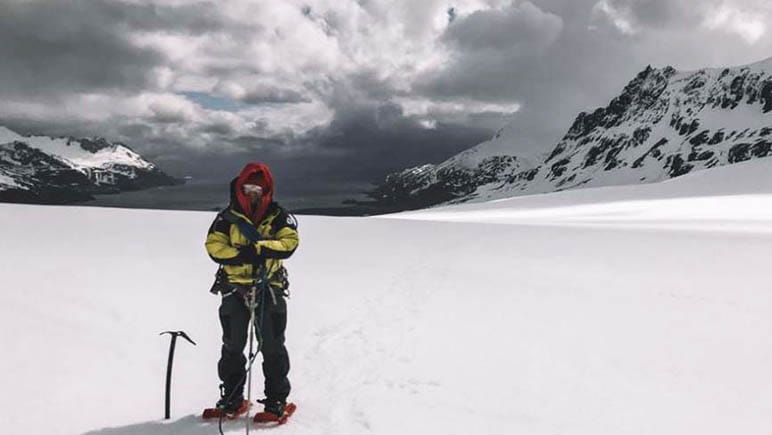Australian virtual reality (VR) specialists and polar adventurers have their sights set on a VR project that will enable users to experience the epic Antarctic journey and survival of Sir Ernest Shackleton more than 100 years ago, while also witnessing the impacts of climate change in the region today.
The VR production, Thin Ice VR, presented by environmental scientist and adventurer Tim Jarvis AM, follows the path of the 1914 expedition to be the first to cross Antarctica coast-to-coast led by experienced British polar explorer Sir Ernest Shackleton. The events that transpired are now regarded by many as the greatest survival journey of all time and a lesson in leadership. Jarvis achieved global acclaim when he became the first person to successfully retrace Shackleton’s journey, which he documented in his 2013 book Shackleton’s Epic: Recreating the World’s Greatest Journey of Survival. In Thin Ice VR, he returns to the Antarctic wilderness that so nearly overcame Shackleton and his crew, but this time with the purpose of highlighting climate change and how it has drastically impacted the region.
Tim Jarvis, explained that the intention of Thin Ice VR is to create meaningful awareness of climate change and allow viewers to come to the personal realisation, through the VR experience, that decisive action needs to be taken.
Using VR to highlight the effects of climate change
“Had Shackleton attempted his mission in 2019, the Antarctic environment would pose a much-diminished threat due to global warming. Thin Ice VR is not a history documentary – it’s very much about the future,” – Tim Jarvis, Environmental Scientist & Adventurer
Thin Ice VR is a ground-breaking application of VR for documentary. Rather than simply present 360-degree footage to the user, the Thin Ice VR team is recreating Antarctic locations in stunningly realistic 3D, using multiple capture techniques to turn images into virtual environments.
“It’s rare to gain access to the wild, rugged wilderness of South Georgia Island and difficult to gain the necessary permits to capture drone and 360-degree footage among the teaming wildlife, glaciers, ravines and derelict whaling stations. With Tim Jarvis and award-winning National Geographic photographer, Doug Gimsey, we accomplished that.
We now have enough funding to create a great experience, however, we want to make Thin Ice VR a ground-breaking application of VR for documentary. We want to create a deeper level of immersion for the user and an opportunity for them to move around a location, evening picking up objects, and to have Tim Jarvis and Ernest Shackleton talk to them – as if they’re there, leading them through the experience,”
– James Calvert, writer and director
With further funding, the production team is looking to push the boundaries of photogrammetry to include interactivity and to use volumetric motion capture to fully exploit the capabilities of the modern VR headset.
Photogrammetry is a technique that uses series of images captured of an object or location, which is then processed and converted into a realistic 3D model. For example, a specific location on South Georgia Island can be ‘scanned’ with digital cameras and then rebuilt at a 1:1 scale in VR for users to freely walk around.
Volumetric capture is a video technique that captures objects, people and performance in 3D space. Both of these innovative techniques, when used in a VR application, give the user a real sense of being there and standing next to someone.
“We want the Thin Ice VR project to present a series of world firsts in its application of cutting-edge technology; in the capture and portrayal of the people and places in virtual reality,” said Mr Wight.
Thin Ice VR is not only the first VR project in South Georgia, Antarctica, but would be the first to apply photogrammetry and volumetric motion capture in the Antarctic.
“We’re excited that, working with Monkeystack and their approach to educational exposure, Torrens University students can gain experience to a production of this scale and complexity; and learn about the innovative techniques being used such as photogrammetry and volumetric capture,” – James Calvert, writer and director
The VR experience, which will be launched towards the end of 2019, is designed for tethered and untethered headsets for a room scale experience, allowing the user to stand on the ice with Tim Jarvis and explore small areas nearby – from the comfort of their own home, school, gallery or museum. The VR experience is expected to be made accessible to a global audience.
Torrens University has announced a significant financial contribution, alongside support already provided from Tim Jarvis, Screen Australia, the South Australian Film Corporation, One Ocean Expeditions, Kathmandu and Monkeystack.
About Sir Ernest Shackleton’s expedition
Sir Ernest Shackleton made his third trip to the Antarctic in 1914 with the ship Endurance, planning to cross Antarctica via the South Pole. The Endurance became trapped in ice early in 1915 and 10 months later, sank. Shackleton and his crew had already abandoned the ship to live on the floating ice. In April 1916, they set off in three small boats, eventually reaching Elephant Island. Shackleton and five of his crew members then went to seek help, spending 16 days crossing more than 1,300 kilometres of ocean to reach South Georgia before trekking over the island’s mountains to a whaling station. The remaining men from the Endurance were rescued in August 1916. Incredibly, no one from Shackleton’s expedition team died.
Thin Ice VR Writer/Director, James Calvert, Design Lecturer at Torrens University
James Calvert is a Lecturer in Media Design at Torrens University. Thin Ice is the second VR project that James has been involved in at Torrens University. In 2017, he was the Project Lead on a VR collaboration between Torrens University and the ABC that immerses school students in the main events of the World War 2 Kokoda track campaign. Photo-realistic 3D recreations of Kokoda locations and artefacts were combined with animated characters, to tell the story of the track and the people that experienced it.
Thin Ice VR Presenter – Tim Jarvis, environmental scientist and adventurer
Tim Jarvis AM is an environmental scientist, author and adventurer. He has undertaken unsupported expeditions to the world’s most remote regions, including the South Pole, the high Arctic, across Australia’s largest desert, the Great Victoria and retracing the polar journey of Sir Douglas Mawson using only the same gear, equipment and starvation rations as Mawson did in 1913. In 2013, Tim led the first authentic retracing of Sir Ernest Shackleton’s journey, sailing a replica James Caird boat 1,500 kilometres across the Southern Ocean from Elephant Island, Antarctica to South Georgia and climbing over South Georgia’s mountains using the same rudimentary equipment, period clothing and technology as Shackleton. In November 2018, Tim and his team travelled back to South Georgia to record visual and audio content for the Thin Ice VR project.
Thin Ice VR Producer – Justin Wight, Director, Monkeystack
Monkeystack is an award-winning animation and game production company based in Adelaide that creates digital content for any screen, anywhere, working wonders in animation, games, apps, web, VR, AR, MR, motion design and special effects. Director, Justin Wight, began his career as an animator and now has more than 15 years of industry experience where he’s directed and produced animation series, short films and games across TV, web, film, PC and mobile devices.




